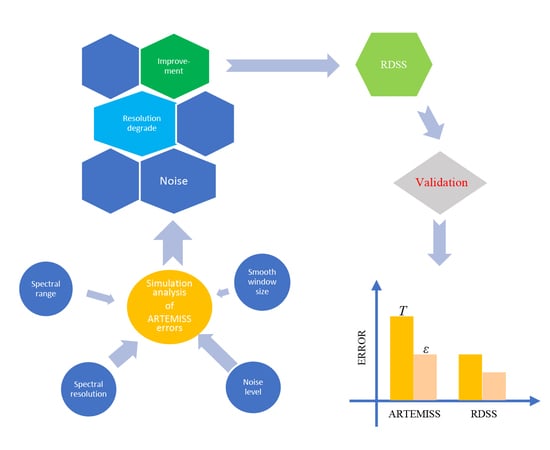Noise-sensitivity Analysis and Improvement of Automatic Retrieval of Temperature and Emissivity Using Spectral Smoothness
Abstract
1. Introduction
2. Background
3. Sensitivity Analysis of ARTEMISS
3.1. Simulation Experiment
3.2. Results Analysis
3.2.1. The Relationship of the Retrieval Errors of ARTEMISS vs. the Noise Level and Spectral Parameters
3.2.2. The Relationship of the Retrieval Errors vs. the Optimal Window Size Spectral Smoothing
4. The Proposal and Validation of the RDSS Algorithm
4.1. RDSS—An Improved TES Algorithm Based on ARTEMISS
4.2. Validation Results Analysis
4.2.1. The Retrieval Errors of the RDSS Algorithm
4.2.2. The Relationship of RDSS and the Window Setting
5. Discussion
6. Conclusions
Author Contributions
Funding
Acknowledgments
Conflicts of Interest
References
- Aslett, Z.; Taranik, J.V.; Riley, D.N. Mapping Rock-forming Minerals at Daylight Pass, Death Valley National Park, California, Using SEBASS Thermal-infrared Hyperspectral Image Data. In Proceedings of the 2008 IEEE International Geoscience and Remote Sensing Symposium, Boston, MA, USA, 7–11 July 2008; IEEE Press: Piscataway, NJ, USA, 2009; pp. 366–369. [Google Scholar]
- Cui, J.; Yan, B.; Dong, X.; Zhang, S.; Zhang, J.; Tian, F.; Wang, R. Temperature and emissivity separation and mineral mapping based on airborne TASI hyperspectral thermal infrared data. Int. J. Appl. Earth Obs. Geoinf. 2015, 40, 19–28. [Google Scholar] [CrossRef]
- Vaughan, R.G.; Calvin, W.M.; Taranik, J.V. SEBASS hyperspectral thermal infrared data: Surface emissivity measurement and mineral mapping. Remote Sens. Environ. 2003, 85, 48–63. [Google Scholar] [CrossRef]
- Johnson, W.; Hulley, G.; Hook, S. Remote gas plume sensing and imaging with NASA’s Hyperspectral Thermal Emission Spectrometer (HyTES). In Proceedings of the SPIE Sensing Technology + Applications, Baltimore, MA, USA, 28 May 2014; pp. 91010V-1–91010V-7. [Google Scholar]
- Palombo, A.; Pascucci, S.; Loperte, A.; Lettino, A.; Castaldi, F.; Muolo, M.R.; Santini, F. Soil Moisture Retrieval by Integrating TASI-600 Airborne Thermal Data, WorldView 2 Satellite Data and Field Measurements: Petacciato Case Study. Sensors 2019, 19, 1515. [Google Scholar] [CrossRef]
- Guo, G.; Liu, B.; Liu, C. Thermal Infrared Spectral Characteristics of Bunker Fuel Oil to Determine Oil-Film Thickness and API. J. Mar. Sci. Eng. 2020, 8, 135. [Google Scholar] [CrossRef]
- Wan, Z.; Dozier, J. A generalized split-window algorithm for retrieving land-surface temperature from space. IEEE Trans. Geosci. Remote Sens. 1996, 34, 892–905. [Google Scholar] [CrossRef]
- Barducci, A.; Pippi, I. Temperature and Emissivity Retrieval from remotely sensed images using the “grey body emissivity” method. IEEE Trans. Geosci. Remote Sens. 1996, 34, 681–695. [Google Scholar] [CrossRef]
- Kahle, A.B.; Madura, D.P.; Soha, J.M. Middle infrared multispectral aircraft scanner data: Analysis for geological applications. Appl. Opt. 1980, 19, 2279–2290. [Google Scholar] [CrossRef]
- Gillespie, A.R. Lithologic mapping of silicate rocks using TIMS. In Proceedings of the TIMS Data Users’ Workshop, Pasadena, CA, USA, 18–19 June 1985; pp. 29–44. [Google Scholar]
- Realmuto, V.J. Separating the effects of temperature and emissivity: Emissivity spectrum normalization. In Proceedings of the Second Thermal Infrared Multispectral Scanner (TIMS) Workshop, Pasadena, CA, USA, 22 May 1991; pp. 31–35. [Google Scholar]
- Becker, F.; Li, Z.-L. Temperature-independent spectral indices in thermal infrared bands. Remote Sens. Environ. 1990, 32, 17–33. [Google Scholar] [CrossRef]
- Watson, K. Spectral ratio method for measuring emissivity. Remote Sens. Environ. 1992, 42, 113–116. [Google Scholar] [CrossRef]
- De Griend, A.A.V.; Owe, M. On the relationship between thermal emissivity and the normalized difference vegetation index for natural surfaces. Int. J. Remote Sens. 1993, 14, 1119–1131. [Google Scholar] [CrossRef]
- Valor, E.; Caselles, V. Mapping land surface emissivity from NDVI: Application to European, African, and South American areas. Remote Sens. Environ. 1996, 57, 167–184. [Google Scholar] [CrossRef]
- Sobrino, J.A.; Raissouni, N. Toward remote sensing methods for land cover dynamic monitoring: Application to Morocco. Int. J. Remote Sens. 2000, 21, 353–366. [Google Scholar] [CrossRef]
- Sobrino, J.A.; Raissouni, N.; Li, Z.-L. A Comparative Study of Land Surface Emissivity Retrieval from NOAA Data. Remote Sens. Environ. 2001, 75, 256–266. [Google Scholar] [CrossRef]
- Abrams, M. The Advanced Spaceborne Thermal Emission and Reflection Radiometer (ASTER): Data products for the high spatial resolution imager on NASA’s Terra platform. Int. J. Remote Sens. 2000, 21, 847–859. [Google Scholar] [CrossRef]
- Li, Z.-L.; Wu, H.; Wang, N.; Qiu, S.; Sobrino, J.A.; Wan, Z.; Tang, B.-H.; Yan, G. Land surface emissivity retrieval from satellite data. Int. J. Remote Sens. 2013, 34, 3084–3127. [Google Scholar] [CrossRef]
- Salisbury, J.W.; D’Aria, D.M. Emissivity of terrestrial materials in the 8–14 μm atmospheric window. Remote Sens. Environ. 1992, 42, 83–106. [Google Scholar] [CrossRef]
- Borel, C. Iterative Retrieval of Surface Emissivity and Temperature for a Hyperspectral Sensor. In Proceedings of the First JPL Workshop on Remote Sensing of Land Surface Emissivity, Pasadena, CA, USA, 6–8 May 1997. [Google Scholar]
- Borel, C.C. ARTEMISS–an algorithm to retrieve temperature and emissivity from hyper-spectral thermal image data. In Proceedings of the 28th Annual GOMACTech Conference, Hyperspectral Imaging Session, Tampa, FL, USA, 31 March–3 April 2003; pp. 1–4. [Google Scholar]
- Borel, C.; Rosario, D.; Romano, J. Data processing and temperature-emissivity separation for tower-based imaging Fourier transform spectrometer data. Int. J. Remote Sens. 2015, 36, 4779–4792. [Google Scholar] [CrossRef]
- Kanani, K.; Poutier, L.; Nerry, F.; Stoll, M.-P. Directional Effects Consideration to Improve out-doors Emissivity Retrieval in the 3–13 µm Domain. Opt. Express 2007, 15, 12464–12482. [Google Scholar] [CrossRef]
- Wang, X.; OuYang, X.; Tang, B.; Li, Z.; Zhang, R. A New Method for Temperature/Emissivity Separation from Hyperspectral Thermal Infrared Data. In Proceedings of the IGARSS 2008—2008 IEEE International Geoscience and Remote Sensing Symposium, Boston, MA, USA, 7–11 July 2008; pp. 286–289. [Google Scholar]
- Cheng, J.; Liu, Q.; Li, X.; Xiao, Q.; Liu, Q.; Du, Y. Correlation-based temperature and emissivity separation algorithm. Sci. China Ser. D Earth Sci. 2008, 51, 357–369. [Google Scholar] [CrossRef]
- Cheng, J.; Liang, S.; Wang, J.; Li, X. A Stepwise Refining Algorithm of Temperature and Emissivity Separation for Hyperspectral Thermal Infrared Data. IEEE Trans. Geosci. Remote Sens. 2010, 48, 1588–1597. [Google Scholar] [CrossRef]
- Zhao, H.; Li, J.; Jia, G.; Qiu, X. Correlation-wavelet method for separation of hyperspectral thermal infrared temperature and emissivity. Opt. Precis. Eng. 2019, 27, 1737–1744. [Google Scholar] [CrossRef]
- Chen, M.; Jiang, X.; Wu, H.; Qian, Y.; Wang, N. Temperature and emissivity retrieval from low-emissivity materials using hyperspectral thermal infrared data. Int. J. Remote Sens. 2019, 40, 1655–1671. [Google Scholar] [CrossRef]
- Wang, N.; Wu, H.; Nerry, F.; Li, C.; Li, Z. Temperature and Emissivity Retrievals From Hyperspectral Thermal Infrared Data Using Linear Spectral Emissivity Constraint. IEEE Trans. Geosci. Remote Sens. 2011, 49, 1291–1303. [Google Scholar] [CrossRef]
- Ni, L.; Wu, H.; Zhang, B.; Zhang, W.; Gao, L. Improvement of linear spectral emissivity constraint method for temperature and emissivity separation of hyperspectral thermal infrared data. In Proceedings of the 2015 7th Workshop on Hyperspectral Image and Signal Processing: Evolution in Remote Sensing (WHISPERS), Tokyo, Japan, 2–5 June 2015; pp. 1–4. [Google Scholar]
- Lan, X.; Zhao, E.; Li, Z.-L.; Labed, J.; Nerry, F. An Improved Linear Spectral Emissivity Constraint Method for Temperature and Emissivity Separation Using Hyperspectral Thermal Infrared Data. Sensors 2019, 19, 5552. [Google Scholar] [CrossRef]
- Zhang, Y.-Z.; Wu, H.; Jiang, X.-G.; Jiang, Y.-Z.; Liu, Z.-X.; Nerry, F. Land Surface Temperature and Emissivity Retrieval from Field-Measured Hyperspectral Thermal Infrared Data Using Wavelet Transform. Remote Sens. 2017, 9, 454. [Google Scholar] [CrossRef]
- Zhou, S.; Cheng, J. A multi-scale wavelet-based temperature and emissivity separation algorithm for hyperspectral thermal infrared data. Int. J. Remote Sens. 2018, 39, 8092–8112. [Google Scholar] [CrossRef]
- Acito, N.; Diani, M.; Corsini, G. Dictionary Based Temperature and Emissivity Separation Algorithm in LWIR Hyperspectral Data. In Proceedings of the 2018 9th Workshop on Hyperspectral Image and Signal Processing: Evolution in Remote Sensing (WHISPERS), Amsterdam, Netherlands, 23–26 September 2018; pp. 1–5. [Google Scholar]
- Acito, N.; Diani, M.; Corsini, G. Subspace-Based Temperature and Emissivity Separation Algorithms in LWIR Hyperspectral Data. IEEE Trans. Geosci. Remote Sens. 2019, 57, 1523–1537. [Google Scholar] [CrossRef]
- Ingram, P.M.; Muse, A.H. Sensitivity of iterative spectrally smooth temperature/emissivity separation to algorithmic assumptions and measurement noise. IEEE Trans. Geosci. Remote Sens. 2001, 39, 2158–2167. [Google Scholar] [CrossRef]
- Cheng, J.; Xiao, Q.; Liu, Q.; Li, X. Effects of Smoothness Index on the Accuracy of Iterative Spectrally Smooth Temperature/Emissivity Separation Algorithm. J. Atmos. Environ. Opt. 2007, 2, 376–380. [Google Scholar]
- Cheng, J.; Du, Y.; Liu, Q.; Li, X.; Xiao, Q.; Liu, Q. Analysis of the Non-isothermal Effects on the Temperature/Emissvity Separation of Flat Mixed Pixel. J. Atmos. Environ. Opt. 2008, 3, 57–64. [Google Scholar]
- Borel, C. Error analysis for a temperature and emissivity retrieval algorithm for hyperspectral imaging data. Int. J. Remote Sens. 2008, 29, 5029–5045. [Google Scholar] [CrossRef]
- OuYang, X.; Wang, N.; Wu, H.; Li, Z.-L. Errors analysis on temperature and emissivity determination from hyperspectral thermal infrared data. Opt. Express 2010, 18, 544–550. [Google Scholar] [CrossRef]
- Borel, C.C. Temperature-Emissivity Separation Algorithms for Hyperspectral Imaging Spectrometers. In Proceedings of the Fourier Transform Spectroscopy and Hyperspectral Imaging and Sounding of the Environment, Lake Arrowhead, CA, USA, 1–4 March 2015. [Google Scholar]
- Qian, Y.; Wang, N.; Ma, L.; Mengshuo, C.; Wu, H.; Liu, L.; Han, Q.; Gao, C.; Yuanyuan, J.; Tang, L.; et al. Evaluation of Temperature and Emissivity Retrieval using Spectral Smoothness Method for Low-Emissivity Materials. IEEE J. Sel. Top. Appl. Earth Obs. Remote Sens. 2016, 9, 4307–4315. [Google Scholar] [CrossRef]
- Pieper, M.; Manolakis, D.; Truslow, E.; Cooley, T.; Brueggeman, M.; Jacobson, J.; Weisner, A. Performance limitations of temperature–emissivity separation techniques in long-wave infrared hyperspectral imaging applications. Opt. Eng. 2017, 56, 081804. [Google Scholar] [CrossRef]
- Pieper, M.; Manolakis, D.; Truslow, E.; Jacobson, J.; Weisner, A.; Cooley, T.; Ingle, V. Sensitivity of Temperature and Emissivity Separation to Atmospheric Errors in LWIR Hyperspectral Imagery; SPIE: Bellingham, WA, USA, 2018; Volume 10644. [Google Scholar]
- Pieper, M.; Manolakis, D.G.; Truslow, E.; Cooley, T.; Brueggeman, M.; Jacobson, J.; Weisner, A. Effects of Wavelength Calibration Mismatch on Temperature-Emissivity Separation Techniques. IEEE J. Sel. Top. Appl. Earth Obs. Remote Sens. 2018, 11, 1315–1324. [Google Scholar] [CrossRef]
- Wang, N.; Qian, Y.; Wu, H.; Ma, L.; Tang, L.; Li, C. Evaluation and comparison of hyperspectral temperature and emissivity separation methods influenced by sensor spectral properties. Int. J. Remote Sens. 2019, 40, 1693–1708. [Google Scholar] [CrossRef]
- Shao, H.; Liu, C.; Li, C.; Wang, J.; Xie, F. Temperature and Emissivity Inversion Accuracy of Spectral Parameter Changes and Noise of Hyperspectral Thermal Infrared Imaging Spectrometers. Sensors 2020, 20, 2109. [Google Scholar] [CrossRef] [PubMed]
- Xie, F.; Liu, C.; Shao, H.; Zhang, C.; Yang, G.; Wang, J. Scene-based spectral calibration for thermal infrared hyperspectral data. Infrared Laser Eng. 2017, 46. [Google Scholar] [CrossRef]
- Gu, D.; Gillespie, A.R.; Kahle, A.B.; Palluconi, F.D. Autonomous atmospheric compensation (AAC) of high resolution hyperspectral thermal infrared remote-sensing imagery. IEEE Trans. Geosci. Remote Sens. 2000, 38, 2557–2570. [Google Scholar] [CrossRef]
- Young, S.J. An in-scene method for atmospheric compensation of thermal hyperspectral data. J. Geophys. Res. 2002, 107, 20. [Google Scholar] [CrossRef]
- Chandrasekhar, S. Radiative Transfer; Dover: New York, NY, USA, 1960. [Google Scholar]
- Lenoble, J. Radiative Transfer in Scattering and Absorbing Atmospheres: Standard Computational Procedures; A. Deepak: Hampton, VA, USA, 1985. [Google Scholar]
- Hulley, G.C.; Duren, R.M.; Hopkins, F.M.; Hook, S.J.; Vance, N.; Guillevic, P.C.; Johnson, W.R.; Eng, B.T.; Mihaly, J.M.; Jovanovic, V.M.; et al. High spatial resolution imaging of methane and other trace gases with the airborne Hyperspectral Thermal Emission Spectrometer (HyTES). Atmos. Meas. Tech. 2016, 9, 2393–2408. [Google Scholar] [CrossRef]
- Yuan, L.; He, Z.; Lv, G.; Wang, Y.; Li, C.; Xie, J.n.; Wang, J. Optical design, laboratory test, and calibration of airborne long wave infrared imaging spectrometer. Opt. Express 2017, 25, 22440–22454. [Google Scholar] [CrossRef]
- Hook, S.J.; Eng, B.T.; Gunapala, S.D.; Hill, C.J.; Johnson, W.R.; Lamborn, A.U.; Mouroulis, P.; Mumolo, J.M.; Realmuto, V.J.; Paine, C.G. Qwest and HyTES: Two New Hyperspectral Thermal Infrared Imaging Spectrometers for Earth Science. In Proceedings of the SET-151 Specialist Meeting on Thermal Hyperspectral Imagery, Brussels, Belgium, 26–27 October 2009; NATORTO: Brussels, Belgium, 2009; pp. 1–8. [Google Scholar]
- Jiménez-Muñoz, J.C.; Sobrino, J.A.; Skoković, D.; Mattar, C.; Cristóbal, J. Land Surface Temperature Retrieval Methods From Landsat-8 Thermal Infrared Sensor Data. IEEE Geosci. Remote Sens. Lett. 2014, 11, 1840–1843. [Google Scholar] [CrossRef]
- Lahraoua, M.; Raissouni, N.; Chahboun, A.; Azyat, A.; Achhab, N.B. Split-Window LST Algorithms Estimation From AVHRR/NOAA Satellites (7, 9, 11, 12, 14, 15, 16, 17, 18, 19) Using Gaussian Filter Function. Int. J. Inf. Netw. Secur. 2012, 2, 68–77. [Google Scholar] [CrossRef]
- Johnson, W.R.; Hook, S.J.; Mouroulis, P.; Wilson, D.W.; Gunapala, S.D.; Realmuto, V.; Lamborn, A.; Paine, C.; Mumolo, J.M.; Eng, B.T. HyTES: Thermal imaging spectrometer development. In Proceedings of the 2011 Aerospace Conference, Big Sky, MT, USA, 5–12 March 2011; pp. 1–8. [Google Scholar]
- MODTRAN. Available online: http://modtran.spectral.com/ (accessed on 7 July 2020).
- Baldridge, A.M.; Hook, S.J.; Grove, C.I.; Rivera, G. The ASTER spectral library version 2.0. Remote Sens. Environ. 2009, 113, 711–715. [Google Scholar] [CrossRef]
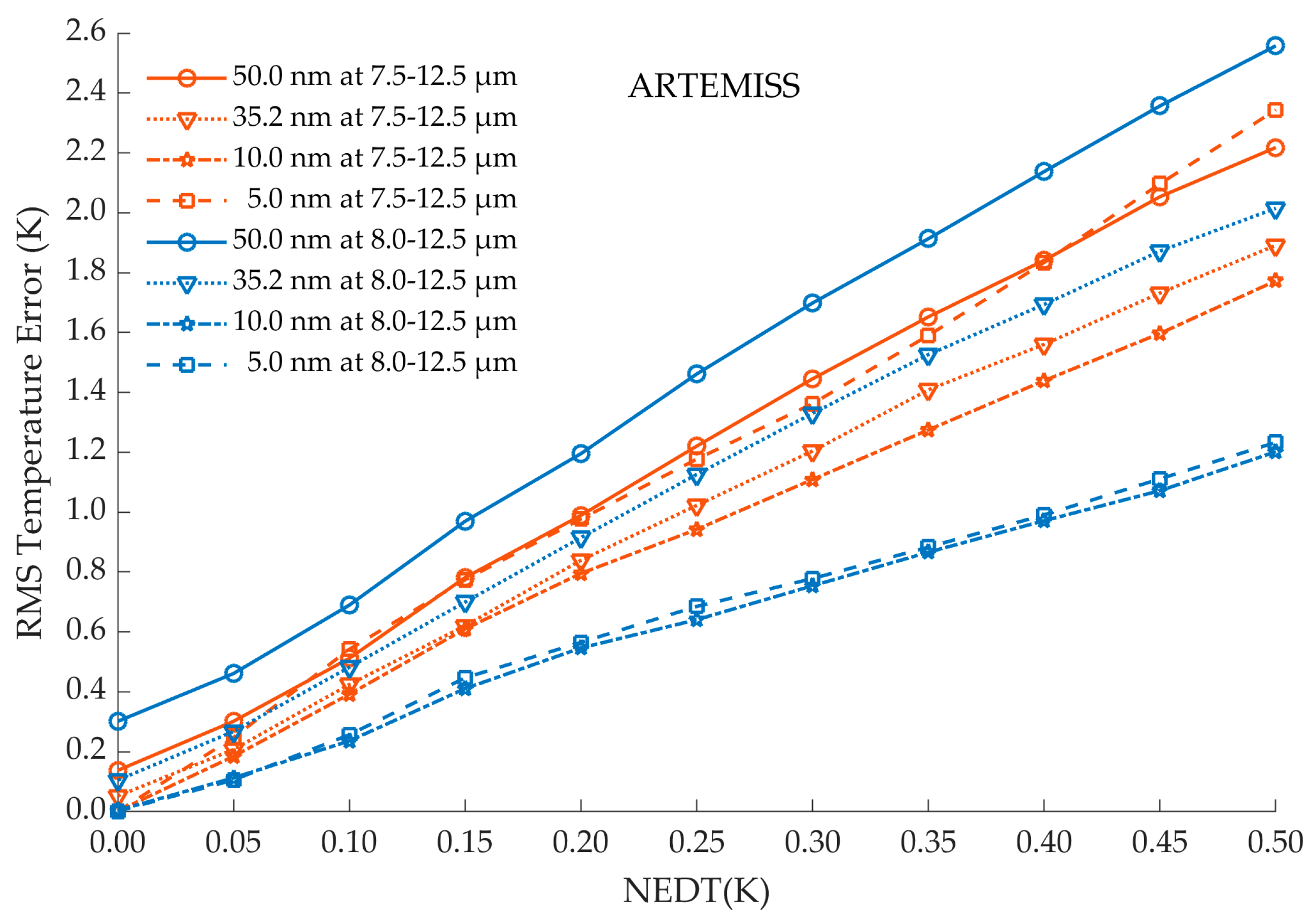

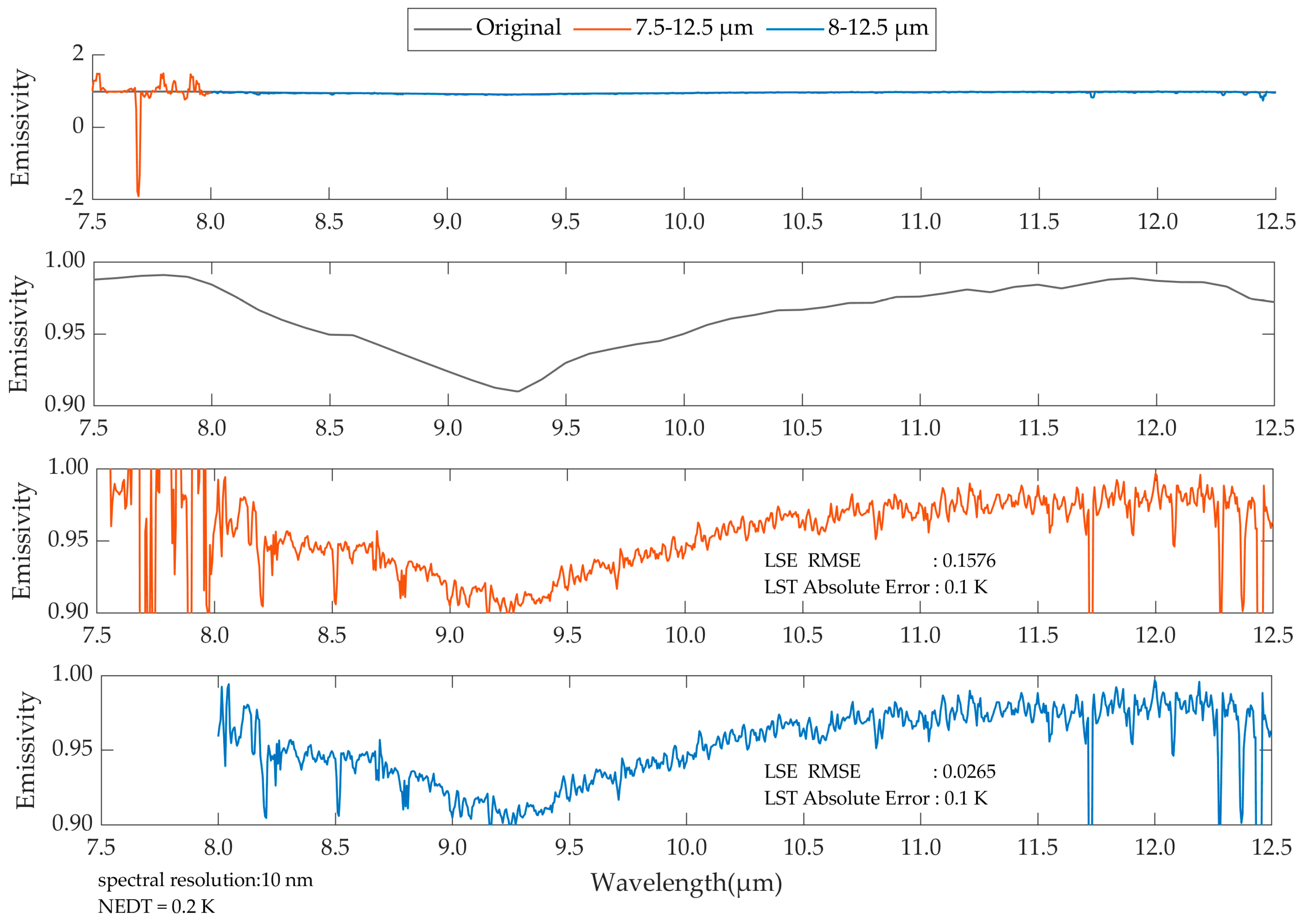


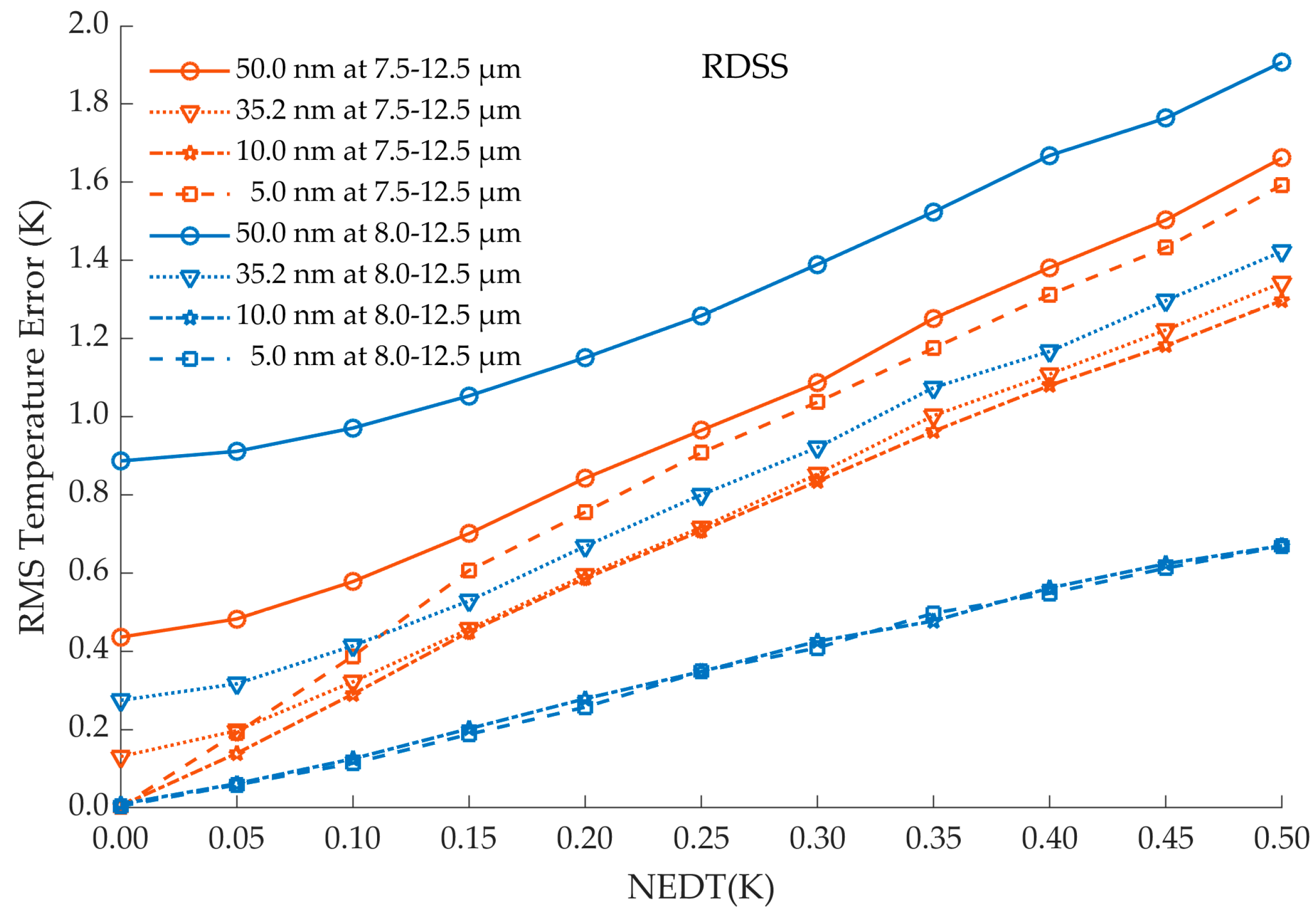
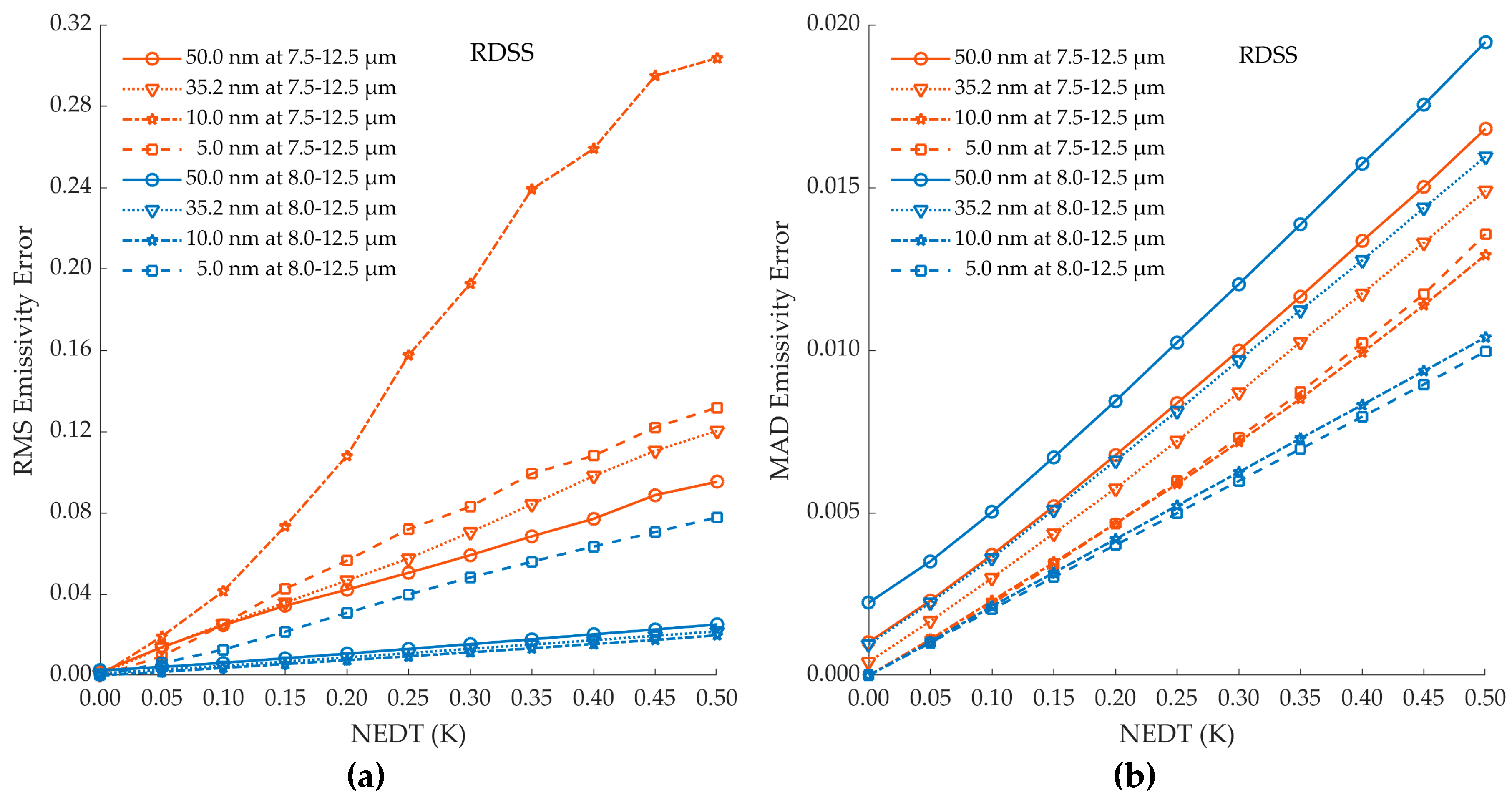

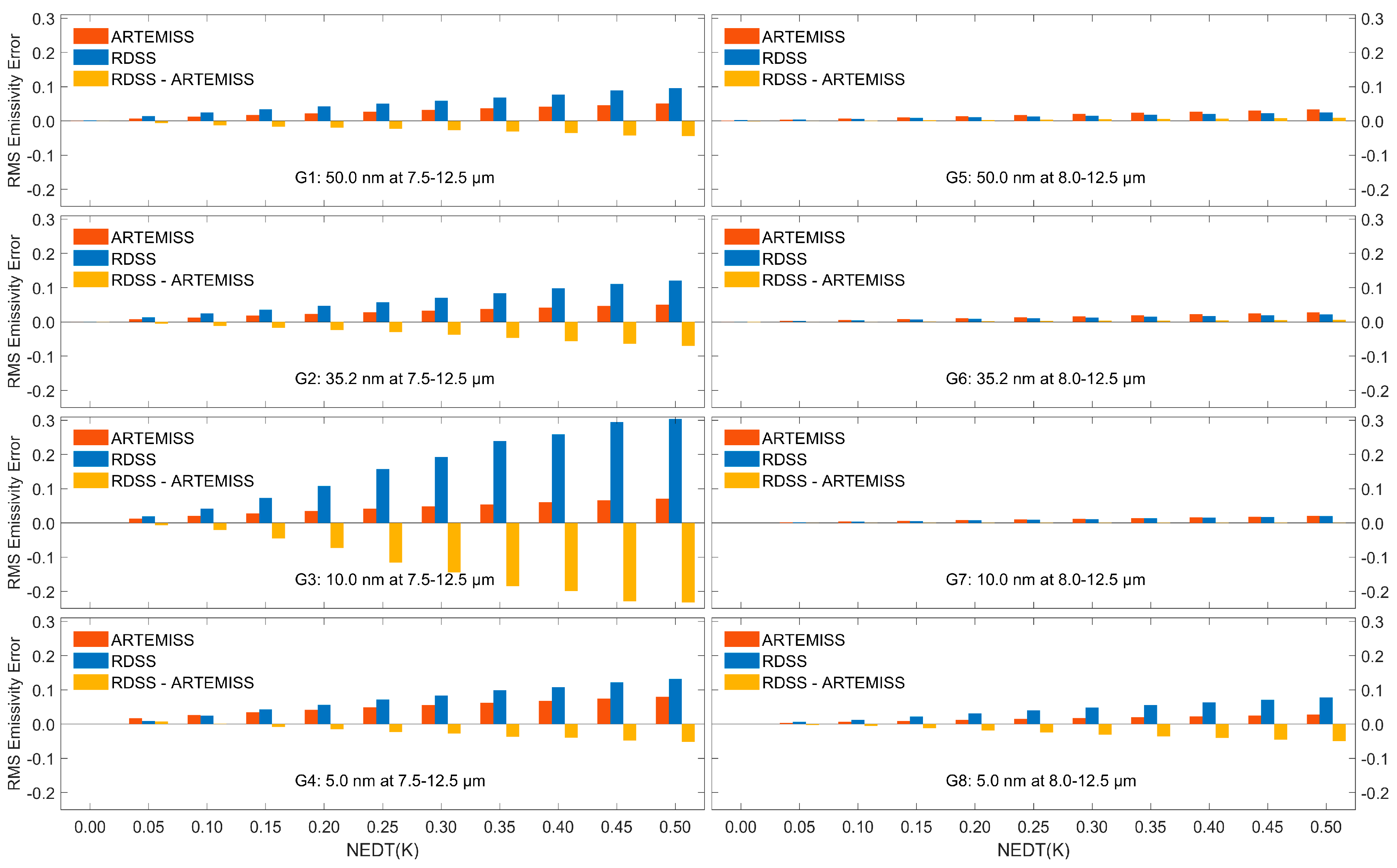
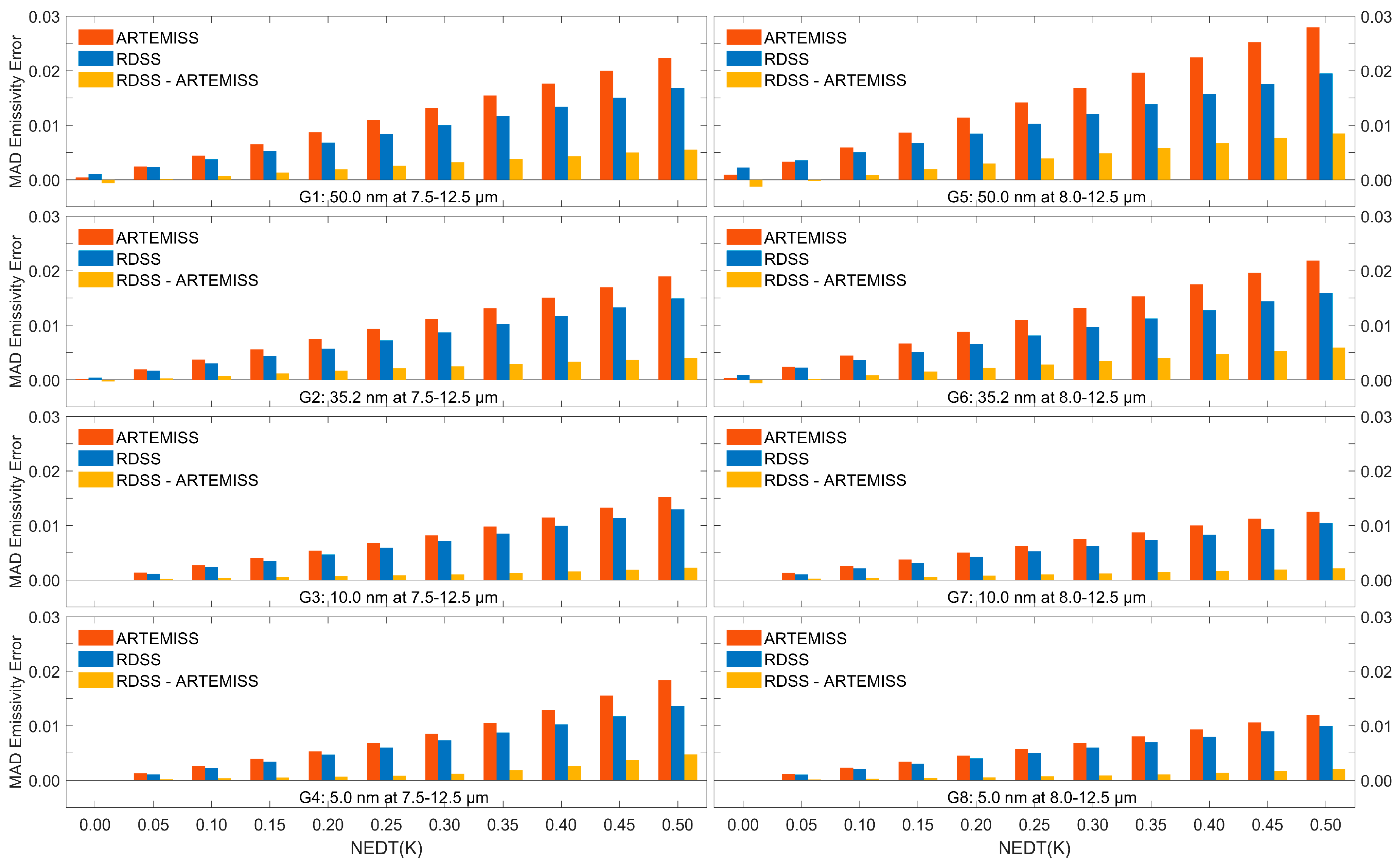
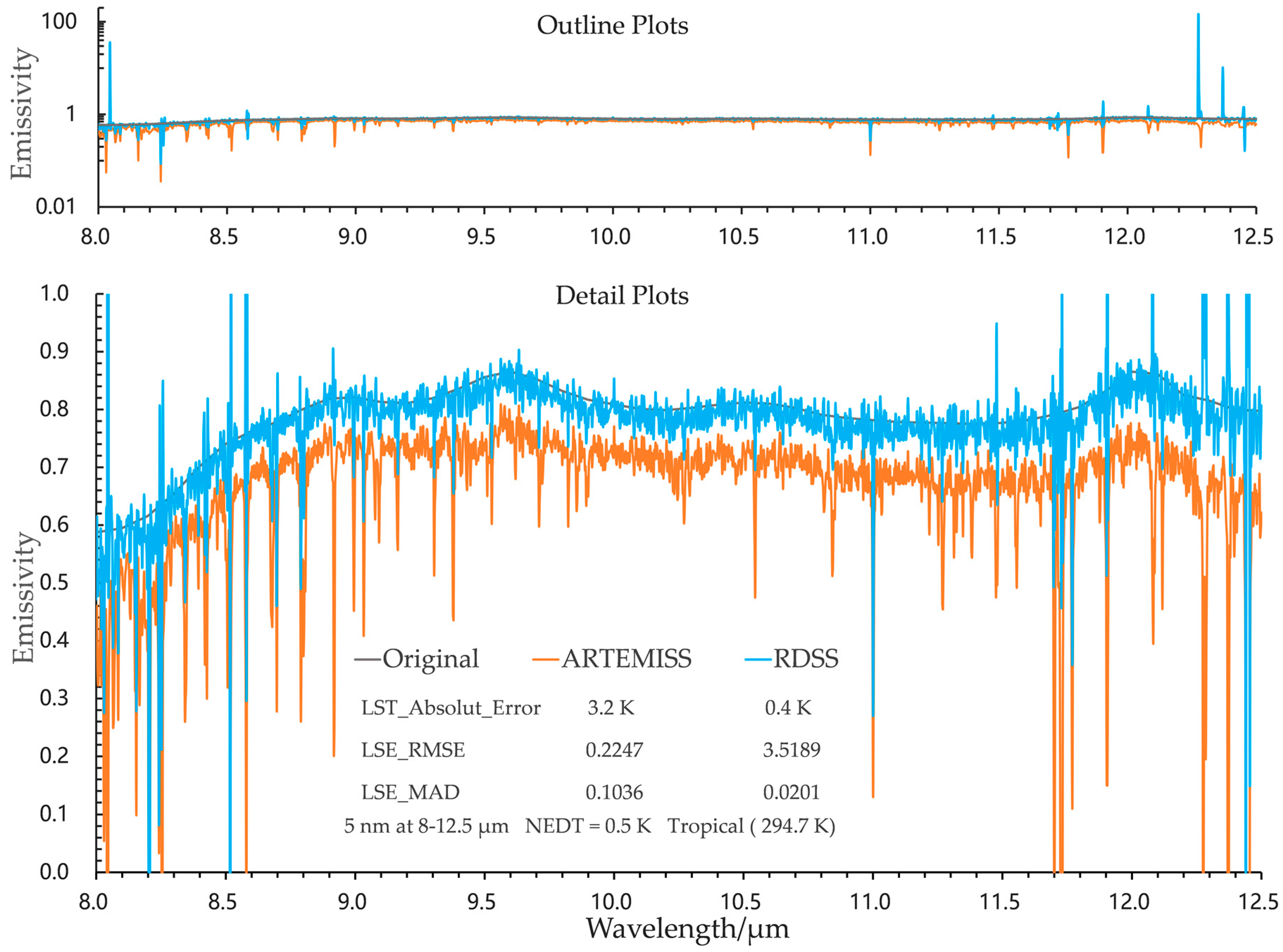
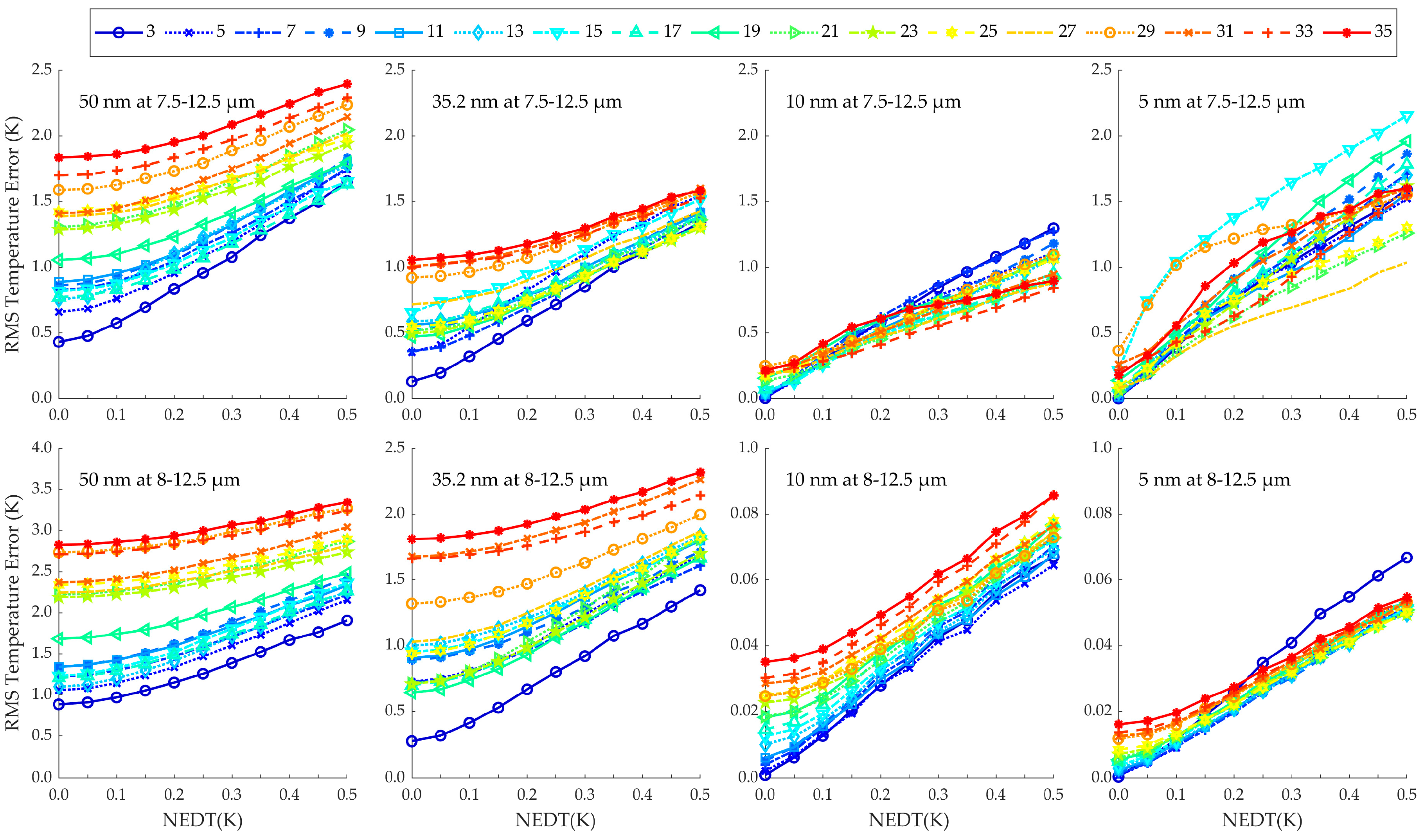
| Variable | Value | Number |
|---|---|---|
| Spectral range | 7.5–12.5 μm, 8–12.5 μm | 2 |
| Random noise | From 0 to 0.5 K with an incremental step of 0.05 K | 11 |
| Spectral resolution | 50 nm, 35 nm, 10 nm, 5 nm | 4 |
| Sensor altitude | 2 km, 10 km, 750 km | 3 |
| LST | Atmospheric temperature + offset | 6 |
| Offset: | ||
| (1) from −5 K to 20 K with an incremental step of 5 K when atmospheric temperature ≤ 280 K; | ||
| (2) from −10 K to 15 K with an incremental step of 5 K when atmospheric temperature > 280 K. | ||
| LSE | All emissivity spectra covering thermal infrared wavelengths from ASTER 2.0 | 1524 |
| Atmospheric model | Tropical Model, 299.7 K | 5 |
| Mid-Latitude Summer Model, 294.2 K | ||
| Mid-Latitude Winter Model, 272.2 K | ||
| Sub-Arctic Summer Model, 287.2 K | ||
| Sub-Arctic Winter Model, 257.2 K | ||
| Total | — | 12,070,080 |
| Name | Spectral Range/μm | Spectral Resolution/nm | Similar Sensor |
|---|---|---|---|
| Group1 | 7.5–12.5 | 50 | |
| Group2 | 7.5–12.5 | 35.2 | HyTES |
| Group3 | 7.5–12.5 | 10 | |
| Group4 | 7.5–12.5 | 5 | |
| Group5 | 8–12.5 | 50 | ATHIS |
| Group6 | 8–12.5 | 35.2 | |
| Group7 | 8–12.5 | 10 | |
| Group8 | 8–12.5 | 5 |
| Groups\NEDT(K) | 0.00 | 0.05 | 0.10 | 0.15 | 0.20 | 0.25 | 0.30 | 0.35 | 0.40 | 0.45 | 0.50 | |
|---|---|---|---|---|---|---|---|---|---|---|---|---|
| G1 1 | A 2 | 0.14 | 0.30 | 0.51 | 0.78 | 0.99 | 1.22 | 1.45 | 1.65 | 1.84 | 2.05 | 2.22 |
| R 3 | 0.44 | 0.48 | 0.58 | 0.70 | 0.84 | 0.96 | 1.09 | 1.25 | 1.38 | 1.50 | 1.66 | |
| Dif 4 | −0.30 | −0.18 | −0.07 | 0.08 | 0.15 | 0.26 | 0.36 | 0.40 | 0.46 | 0.55 | 0.56 | |
| RDif 5 | — | — | — | 10% | 15% | 21% | 25% | 24% | 25% | 27% | 25% | |
| G2 | A | 0.05 | 0.21 | 0.42 | 0.62 | 0.84 | 1.02 | 1.20 | 1.41 | 1.56 | 1.73 | 1.89 |
| R | 0.13 | 0.20 | 0.32 | 0.46 | 0.59 | 0.72 | 0.85 | 1.00 | 1.11 | 1.22 | 1.34 | |
| Dif | −0.08 | 0.01 | 0.10 | 0.16 | 0.24 | 0.31 | 0.35 | 0.41 | 0.45 | 0.51 | 0.55 | |
| RDif | — | 5% | 24% | 26% | 29% | 30% | 29% | 29% | 29% | 29% | 29% | |
| G3 | A | 0.00 | 0.19 | 0.39 | 0.61 | 0.80 | 0.94 | 1.11 | 1.27 | 1.44 | 1.60 | 1.77 |
| R | 0.01 | 0.14 | 0.29 | 0.45 | 0.59 | 0.71 | 0.83 | 0.96 | 1.08 | 1.18 | 1.30 | |
| Dif | 0.00 | 0.05 | 0.10 | 0.16 | 0.21 | 0.23 | 0.27 | 0.31 | 0.36 | 0.42 | 0.48 | |
| RDif | — | 26% | 26% | 26% | 26% | 24% | 24% | 24% | 25% | 26% | 27% | |
| G4 | A | 0.00 | 0.25 | 0.54 | 0.77 | 0.98 | 1.18 | 1.36 | 1.59 | 1.83 | 2.10 | 2.34 |
| R | 0.00 | 0.19 | 0.39 | 0.61 | 0.76 | 0.91 | 1.04 | 1.18 | 1.31 | 1.43 | 1.59 | |
| Dif | 0.00 | 0.06 | 0.15 | 0.17 | 0.22 | 0.27 | 0.33 | 0.41 | 0.52 | 0.66 | 0.75 | |
| RDif | — | 24% | 28% | 22% | 22% | 23% | 24% | 26% | 28% | 31% | 32% | |
| G5 | A | 0.30 | 0.46 | 0.69 | 0.97 | 1.20 | 1.46 | 1.70 | 1.91 | 2.14 | 2.36 | 2.56 |
| R | 0.89 | 0.91 | 0.97 | 1.05 | 1.15 | 1.26 | 1.39 | 1.52 | 1.67 | 1.76 | 1.91 | |
| Dif | −0.58 | −0.45 | −0.28 | −0.08 | 0.04 | 0.20 | 0.31 | 0.39 | 0.47 | 0.59 | 0.65 | |
| RDif | — | — | — | — | 3% | 14% | 18% | 20% | 22% | 25% | 25% | |
| G6 | A | 0.11 | 0.27 | 0.48 | 0.70 | 0.92 | 1.13 | 1.33 | 1.53 | 1.69 | 1.87 | 2.02 |
| R | 0.27 | 0.32 | 0.41 | 0.53 | 0.67 | 0.80 | 0.92 | 1.07 | 1.17 | 1.30 | 1.42 | |
| Dif | −0.17 | −0.05 | 0.07 | 0.17 | 0.25 | 0.33 | 0.41 | 0.45 | 0.53 | 0.57 | 0.59 | |
| RDif | — | — | 15% | 24% | 27% | 29% | 31% | 29% | 31% | 30% | 29% | |
| G7 | A | 0.00 | 0.11 | 0.24 | 0.41 | 0.55 | 0.64 | 0.75 | 0.87 | 0.97 | 1.07 | 1.20 |
| R | 0.01 | 0.06 | 0.13 | 0.20 | 0.28 | 0.35 | 0.43 | 0.48 | 0.56 | 0.62 | 0.67 | |
| Dif | 0.00 | 0.05 | 0.11 | 0.21 | 0.27 | 0.29 | 0.33 | 0.39 | 0.41 | 0.45 | 0.53 | |
| RDif | — | 45% | 46% | 51% | 49% | 45% | 44% | 45% | 42% | 42% | 44% | |
| G8 | A | 0.00 | 0.11 | 0.26 | 0.45 | 0.57 | 0.69 | 0.78 | 0.88 | 0.99 | 1.11 | 1.23 |
| R | 0.00 | 0.06 | 0.11 | 0.19 | 0.26 | 0.35 | 0.41 | 0.50 | 0.55 | 0.61 | 0.67 | |
| Dif | 0.00 | 0.05 | 0.14 | 0.26 | 0.31 | 0.34 | 0.37 | 0.39 | 0.44 | 0.50 | 0.57 | |
| RDif | — | 45% | 54% | 58% | 54% | 49% | 47% | 44% | 44% | 45% | 46% | |
| Groups\NEDT(K) | 0.00 | 0.05 | 0.10 | 0.15 | 0.20 | 0.25 | 0.30 | 0.35 | 0.40 | 0.45 | 0.50 | |
|---|---|---|---|---|---|---|---|---|---|---|---|---|
| G1 | A | 0.0005 | 0.0071 | 0.0121 | 0.0173 | 0.0224 | 0.0274 | 0.0322 | 0.0371 | 0.0417 | 0.0464 | 0.0509 |
| R | 0.0016 | 0.0140 | 0.0248 | 0.0343 | 0.0423 | 0.0506 | 0.0592 | 0.0685 | 0.0772 | 0.0888 | 0.0954 | |
| Dif | −0.0011 | −0.0068 | −0.0127 | −0.0171 | −0.0199 | −0.0232 | −0.0270 | −0.0314 | −0.0355 | −0.0425 | −0.0445 | |
| RDif | — | — | — | — | — | — | — | — | — | — | — | |
| G2 | A | 0.0002 | 0.0082 | 0.0133 | 0.0185 | 0.0235 | 0.0283 | 0.0330 | 0.0376 | 0.0420 | 0.0465 | 0.0508 |
| R | 0.0006 | 0.0138 | 0.0254 | 0.0358 | 0.0468 | 0.0576 | 0.0705 | 0.0843 | 0.0982 | 0.1107 | 0.1203 | |
| Dif | −0.0004 | −0.0056 | −0.0121 | −0.0174 | −0.0233 | −0.0293 | −0.0374 | −0.0467 | −0.0562 | −0.0642 | −0.0695 | |
| RDif | — | — | — | — | — | — | — | — | — | — | — | |
| G3 | A | 0.0000 | 0.0127 | 0.0208 | 0.0280 | 0.0348 | 0.0417 | 0.0481 | 0.0544 | 0.0602 | 0.0660 | 0.0710 |
| R | 0.0000 | 0.0192 | 0.0416 | 0.0735 | 0.1081 | 0.1576 | 0.1927 | 0.2392 | 0.2591 | 0.2950 | 0.3037 | |
| Dif | 0.0000 | −0.0065 | −0.0208 | −0.0455 | −0.0733 | −0.1159 | −0.1446 | −0.1848 | −0.1989 | −0.2290 | −0.2327 | |
| RDif | — | — | — | — | — | — | — | — | — | — | — | |
| G4 | A | 0.0000 | 0.0172 | 0.0265 | 0.0345 | 0.0418 | 0.0488 | 0.0554 | 0.0619 | 0.0683 | 0.0741 | 0.0796 |
| R | 0.0000 | 0.0095 | 0.0252 | 0.0427 | 0.0565 | 0.0720 | 0.0831 | 0.0994 | 0.1082 | 0.1221 | 0.1318 | |
| Dif | 0.0000 | 0.0078 | 0.0013 | −0.0082 | −0.0147 | −0.0232 | −0.0277 | −0.0375 | −0.0399 | −0.0480 | −0.0522 | |
| RDif | — | 45% | 5% | — | — | — | — | — | — | — | — | |
| G5 | A | 0.0010 | 0.0039 | 0.0071 | 0.0104 | 0.0138 | 0.0171 | 0.0204 | 0.0238 | 0.0272 | 0.0306 | 0.0339 |
| R | 0.0026 | 0.0042 | 0.0063 | 0.0085 | 0.0108 | 0.0131 | 0.0155 | 0.0179 | 0.0203 | 0.0226 | 0.0251 | |
| Dif | −0.0015 | −0.0003 | 0.0008 | 0.0019 | 0.0030 | 0.0040 | 0.0050 | 0.0059 | 0.0069 | 0.0079 | 0.0088 | |
| RDif | — | — | 11% | 18% | 22% | 23% | 25% | 25% | 25% | 26% | 26% | |
| G6 | A | 0.0004 | 0.0030 | 0.0057 | 0.0084 | 0.0112 | 0.0139 | 0.0167 | 0.0195 | 0.0222 | 0.0250 | 0.0278 |
| R | 0.0011 | 0.0028 | 0.0048 | 0.0068 | 0.0089 | 0.0110 | 0.0132 | 0.0153 | 0.0174 | 0.0196 | 0.0217 | |
| Dif | −0.0007 | 0.0001 | 0.0009 | 0.0016 | 0.0023 | 0.0029 | 0.0036 | 0.0042 | 0.0049 | 0.0054 | 0.0061 | |
| RDif | — | 3% | 16% | 19% | 21% | 21% | 22% | 22% | 22% | 22% | 22% | |
| G7 | A | 0.0000 | 0.0021 | 0.0041 | 0.0061 | 0.0082 | 0.0102 | 0.0122 | 0.0143 | 0.0163 | 0.0183 | 0.0203 |
| R | 0.0000 | 0.0018 | 0.0038 | 0.0057 | 0.0076 | 0.0095 | 0.0115 | 0.0134 | 0.0156 | 0.0175 | 0.0198 | |
| Dif | 0.0000 | 0.0002 | 0.0004 | 0.0005 | 0.0006 | 0.0007 | 0.0007 | 0.0008 | 0.0007 | 0.0008 | 0.0005 | |
| RDif | — | 10% | 10% | 8% | 7% | 7% | 6% | 6% | 4% | 4% | 2% | |
| G8 | A | 0.0000 | 0.0037 | 0.0067 | 0.0095 | 0.0123 | 0.0150 | 0.0175 | 0.0202 | 0.0227 | 0.0254 | 0.0278 |
| R | 0.0000 | 0.0061 | 0.0128 | 0.0216 | 0.0308 | 0.0399 | 0.0483 | 0.0560 | 0.0635 | 0.0706 | 0.0778 | |
| Dif | 0.0000 | −0.0024 | −0.0061 | −0.0120 | −0.0185 | −0.0249 | −0.0307 | −0.0359 | −0.0407 | −0.0453 | −0.0500 | |
| RDif | — | — | — | — | — | — | — | — | — | — | — | |
| Groups\NEDT(K) | 0.00 | 0.05 | 0.10 | 0.15 | 0.20 | 0.25 | 0.30 | 0.35 | 0.40 | 0.45 | 0.50 | |
|---|---|---|---|---|---|---|---|---|---|---|---|---|
| G1 | A | 0.0004 | 0.0024 | 0.0044 | 0.0065 | 0.0087 | 0.0109 | 0.0131 | 0.0154 | 0.0176 | 0.0200 | 0.0223 |
| R | 0.0010 | 0.0023 | 0.0037 | 0.0052 | 0.0068 | 0.0084 | 0.0100 | 0.0116 | 0.0134 | 0.0150 | 0.0168 | |
| Dif | −0.0006 | 0.0001 | 0.0007 | 0.0013 | 0.0019 | 0.0026 | 0.0032 | 0.0038 | 0.0043 | 0.0050 | 0.0055 | |
| RDif | — | 4% | 16% | 20% | 22% | 24% | 24% | 25% | 24% | 25% | 25% | |
| G2 | A | 0.0001 | 0.0020 | 0.0037 | 0.0056 | 0.0075 | 0.0093 | 0.0112 | 0.0131 | 0.0151 | 0.0170 | 0.0190 |
| R | 0.0004 | 0.0017 | 0.0030 | 0.0044 | 0.0058 | 0.0072 | 0.0087 | 0.0102 | 0.0117 | 0.0133 | 0.0149 | |
| Dif | −0.0003 | 0.0003 | 0.0007 | 0.0012 | 0.0017 | 0.0021 | 0.0025 | 0.0029 | 0.0033 | 0.0037 | 0.0041 | |
| RDif | — | 15% | 19% | 21% | 23% | 23% | 22% | 22% | 22% | 22% | 22% | |
| G3 | A | 0.0000 | 0.0013 | 0.0027 | 0.0040 | 0.0054 | 0.0067 | 0.0082 | 0.0098 | 0.0115 | 0.0132 | 0.0152 |
| R | 0.0000 | 0.0011 | 0.0023 | 0.0035 | 0.0047 | 0.0059 | 0.0072 | 0.0085 | 0.0099 | 0.0114 | 0.0129 | |
| Dif | 0.0000 | 0.0002 | 0.0004 | 0.0005 | 0.0007 | 0.0009 | 0.0010 | 0.0013 | 0.0015 | 0.0019 | 0.0022 | |
| RDif | — | 15% | 15% | 13% | 13% | 13% | 12% | 13% | 13% | 14% | 14% | |
| G4 | A | 0.0000 | 0.0013 | 0.0026 | 0.0039 | 0.0053 | 0.0068 | 0.0085 | 0.0105 | 0.0128 | 0.0155 | 0.0183 |
| R | 0.0000 | 0.0011 | 0.0022 | 0.0034 | 0.0047 | 0.0060 | 0.0073 | 0.0087 | 0.0102 | 0.0117 | 0.0136 | |
| Dif | 0.0000 | 0.0002 | 0.0003 | 0.0005 | 0.0006 | 0.0008 | 0.0012 | 0.0018 | 0.0026 | 0.0038 | 0.0047 | |
| RDif | — | 15% | 12% | 13% | 11% | 12% | 14% | 17% | 20% | 25% | 26% | |
| G5 | A | 0.0009 | 0.0033 | 0.0059 | 0.0086 | 0.0114 | 0.0141 | 0.0169 | 0.0196 | 0.0224 | 0.0252 | 0.0279 |
| R | 0.0022 | 0.0035 | 0.0050 | 0.0067 | 0.0084 | 0.0102 | 0.0120 | 0.0139 | 0.0157 | 0.0175 | 0.0195 | |
| Dif | −0.0013 | −0.0002 | 0.0009 | 0.0019 | 0.0029 | 0.0039 | 0.0048 | 0.0058 | 0.0067 | 0.0077 | 0.0085 | |
| RDif | — | — | 15% | 22% | 25% | 28% | 28% | 30% | 30% | 31% | 30% | |
| G6 | A | 0.0003 | 0.0024 | 0.0045 | 0.0066 | 0.0088 | 0.0109 | 0.0132 | 0.0153 | 0.0175 | 0.0197 | 0.0218 |
| R | 0.0010 | 0.0022 | 0.0036 | 0.0051 | 0.0066 | 0.0081 | 0.0097 | 0.0112 | 0.0128 | 0.0144 | 0.0160 | |
| Dif | −0.0006 | 0.0002 | 0.0009 | 0.0015 | 0.0022 | 0.0028 | 0.0035 | 0.0041 | 0.0047 | 0.0053 | 0.0059 | |
| RDif | — | 8% | 20% | 23% | 25% | 26% | 27% | 27% | 27% | 27% | 27% | |
| G7 | A | 0.0000 | 0.0013 | 0.0025 | 0.0038 | 0.0050 | 0.0062 | 0.0075 | 0.0087 | 0.0100 | 0.0112 | 0.0125 |
| R | 0.0000 | 0.0010 | 0.0021 | 0.0032 | 0.0042 | 0.0052 | 0.0063 | 0.0073 | 0.0083 | 0.0094 | 0.0104 | |
| Dif | 0.0000 | 0.0002 | 0.0004 | 0.0006 | 0.0008 | 0.0010 | 0.0012 | 0.0014 | 0.0017 | 0.0019 | 0.0021 | |
| RDif | — | 15% | 16% | 16% | 16% | 16% | 16% | 16% | 17% | 17% | 17% | |
| G8 | A | 0.0000 | 0.0011 | 0.0023 | 0.0034 | 0.0045 | 0.0057 | 0.0069 | 0.0081 | 0.0093 | 0.0106 | 0.0120 |
| R | 0.0000 | 0.0010 | 0.0020 | 0.0030 | 0.0040 | 0.0050 | 0.0060 | 0.0070 | 0.0080 | 0.0090 | 0.0100 | |
| Dif | 0.0000 | 0.0001 | 0.0003 | 0.0004 | 0.0005 | 0.0007 | 0.0009 | 0.0011 | 0.0013 | 0.0016 | 0.0020 | |
| RDif | — | 9% | 13% | 12% | 11% | 12% | 13% | 14% | 14% | 15% | 17% | |
© 2020 by the authors. Licensee MDPI, Basel, Switzerland. This article is an open access article distributed under the terms and conditions of the Creative Commons Attribution (CC BY) license (http://creativecommons.org/licenses/by/4.0/).
Share and Cite
Shao, H.; Liu, C.; Xie, F.; Li, C.; Wang, J. Noise-sensitivity Analysis and Improvement of Automatic Retrieval of Temperature and Emissivity Using Spectral Smoothness. Remote Sens. 2020, 12, 2295. https://doi.org/10.3390/rs12142295
Shao H, Liu C, Xie F, Li C, Wang J. Noise-sensitivity Analysis and Improvement of Automatic Retrieval of Temperature and Emissivity Using Spectral Smoothness. Remote Sensing. 2020; 12(14):2295. https://doi.org/10.3390/rs12142295
Chicago/Turabian StyleShao, Honglan, Chengyu Liu, Feng Xie, Chunlai Li, and Jianyu Wang. 2020. "Noise-sensitivity Analysis and Improvement of Automatic Retrieval of Temperature and Emissivity Using Spectral Smoothness" Remote Sensing 12, no. 14: 2295. https://doi.org/10.3390/rs12142295
APA StyleShao, H., Liu, C., Xie, F., Li, C., & Wang, J. (2020). Noise-sensitivity Analysis and Improvement of Automatic Retrieval of Temperature and Emissivity Using Spectral Smoothness. Remote Sensing, 12(14), 2295. https://doi.org/10.3390/rs12142295




